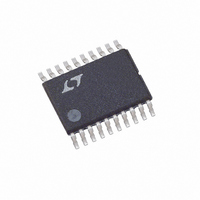LTC3417AIFE-1#PBF Linear Technology, LTC3417AIFE-1#PBF Datasheet - Page 14

LTC3417AIFE-1#PBF
Manufacturer Part Number
LTC3417AIFE-1#PBF
Description
IC BUCK SYNC ADJ 1A/1.5A 20TSSOP
Manufacturer
Linear Technology
Type
Step-Down (Buck)r
Datasheet
1.LTC3417AEDHC-1PBF.pdf
(20 pages)
Specifications of LTC3417AIFE-1#PBF
Internal Switch(s)
Yes
Synchronous Rectifier
Yes
Number Of Outputs
2
Voltage - Output
0.8 ~ 5 V
Current - Output
1A, 1.5A
Frequency - Switching
1.5MHz, 0.6MHz ~ 4MHz
Voltage - Input
2.25 ~ 5.5 V
Operating Temperature
-40°C ~ 125°C
Mounting Type
Surface Mount
Package / Case
20-TSSOP Exposed Pad, 20-eTSSOP, 20-HTSSOP
Lead Free Status / RoHS Status
Lead free / RoHS Compliant
Power - Output
-
APPLICATIONS INFORMATION
LTC3417A-1
14
The I
will provide an adequate starting point for most applica-
tions. The series RC fi lter sets the dominant pole-zero
loop compensation. The values can be modifi ed slightly
(from 0.5 to 2 times their suggested values) to optimize
transient response once the fi nal PC layout is done and
the particular output capacitor type and value have been
determined. The output capacitors need to be selected
because of various types and values determine the loop
feedback factor gain and phase. An output current pulse
of 20% to 100% of full load current having a rise time
of 1μs to 10μs will produce output voltage and I
waveforms that will give a sense of overall loop stability
without breaking the feedback loop.
Switching regulators take several cycles to respond to a
step in load current. When a load step occurs, V
mediately shifts by an amount equal to ΔI
where ESR
ΔI
ing a feedback error signal used by the regulator to return
V
V
indicate a stability problem.
The initial output voltage step may not be within the band-
width of the feedback loop, so the standard second order
overshoot/DC ratio cannot be used to determine phase
margin. The gain of the loop increases with R
bandwidth of the loop increases with decreasing C
R
the zero frequency will be kept the same, thereby keeping
the phase the same in the most critical frequency range
of the feedback loop. In addition, feedforward capacitors,
C1 and C2, can be added to improve the high frequency
response, as shown in Figure 4. Capacitor C1 provides
phase lead by creating a high frequency zero with R1
which improves the phase margin for the 1.5A SW1 chan-
nel. Capacitor C2 provides phase lead by creating a high
frequency zero with R3 which improves the phase margin
for the 1A SW2 channel.
OUT
OUT
ITH
LOAD
is increased by the same factor that C
TH
can be monitored for overshoot or ringing that would
to its steady-state value. During this recovery time,
external components shown in the Figure 4 circuit
also begins to charge or discharge C
COUT
is the effective series resistance of C
ITH
LOAD
is decreased,
OUT
ITH
• ESR
generat-
OUT
and the
TH
ITH
COUT
OUT
im-
pin
. If
,
.
The output voltage settling behavior is related to the stability
of the closed-loop system and will demonstrate the actual
overall supply performance. For a detailed explanation of
optimizing the compensation components, including a
review of control loop theory, refer to Linear Technology
Application Note 76.
Although a buck regulator is capable of providing the full
output current in dropout, it should be noted that as the
input voltage V
does decrease due to the decreasing voltage across the
inductor. Applications that require large load step capabil-
ity near dropout should use a different topology such as
SEPIC, Zeta, or single inductor, positive buck boost.
In some applications, a more severe transient can be
caused by switching in loads with large (>1μF) input ca-
pacitors. The discharged input capacitors are effectively
put in parallel with C
regulator can deliver enough current to prevent this prob-
lem, if the switch connecting the load has low resistance
and is driven quickly. The solution is to limit the turn-on
speed of the load switch driver. A Hot Swap™ controller
is designed specifi cally for this purpose and usually in-
corporates current limiting, short-circuit protection, and
soft- starting.
Effi ciency Considerations
The percent effi ciency of a switching regulator is equal to
the output power divided by the input power times 100.
It is often useful to analyze individual losses to determine
what is limiting the effi ciency and which change would
produce the most improvement. Percent effi ciency can
be expressed as:
where P1, P2, etc. are the individual losses as a percent-
age of input power.
Hot Swap is a trademark of Linear Technology Corporation.
% Effi ciency = 100% – (P1+ P2 + P3 +…)
IN
drops toward V
OUT
, causing a rapid drop in V
OUT
, the load step capability
OUT
3417a1fa
. No












